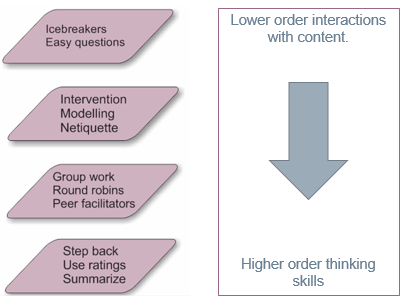Online Facilitation: Top 5 Tips For Online Facilitators
If you are also the designer of your online course there are things to consider that will help when it comes to facilitating the course. Usability and user-friendliness are vital if learners are not to be frustrated right from the start. First impressions count; we all know that.
Designers should provide:
- Clear instructions.
- Formative activities with clear feedback.
Online facilitators should think about:
- Previous courses.
- Welcoming instructions.
- Reviewing any feedback that is available from previous versions of the course and asking questions such as:
- What were the pressure points for participants?
- Were there clear instructions on access?
- How to welcome participants into the course?
- Were sources of help and information easy to find?
All navigation and other links (particularly external URLs) should also be checked before the course begins.
1. Plan carefully and thoroughly.
Formative activities can include small quizzes which are clearly marked as “practice” activities and are non-threatening. Don’t skimp on the feedback; it is not just another chore when composing the quiz. “Good job”, “Well done”, and “Try harder” are all equally unhelpful.
Online facilitators are encouraged to construct their own checklists for a course. See A Checklist for Facilitating Online Courses for a helpful example. A communications plan constructed before the course starts helps you remember what to do and when to do it.
The following is a communication plan example from a course hosted by HRDNZ, Moodle Partner, New Zealand:
2. Use a model.
A model is a way of seeing the world. Gilly Salmon’s model is a “scaffolding” model: It helps facilitators to know and to plan what they should be doing as a course develops over time. The model shows the development of the facilitator role; first off a lot of technical support and motivation via welcoming messages is needed. As the course develops, the participants become less dependent upon the online facilitator and more engaged with each other. Therefore group work is going to be much more effective at later stages than earlier stages. Most of the “heavy lifting” will be done during stages 3 and 4.
3. Use icebreakers.
The aim of icebreakers is to reduce anxiety and promote interactions. Getting to know people is important in reducing anxiety. You can have activities that are completely unrelated to the course material (stranded on desert islands, favorite food/color/music, magic wands, etc.) which promote the fun element.
You can also relate to expectations to discover what these are and make this a group activity. In face to face workshops you may have participants introduce each other; you can do this online too. If you can do some of these and relate them to the course content, I personally feel that that is a good approach. As a facilitator you get a feel for what people expect and maybe what they already know.
4. Pay attention to learner motivation.
In order to motivate and engage the learners you need to know why they are taking the course; another use for an icebreaker. Were they made to or did they volunteer? This can obviously have a tremendous effect. Give them good reasons to participate; if they are bored or un-motivated, be aware that they might be negative in their dealings with others and be prepared to email them privately. Otherwise group work could be affected too.
The course should have some good formative activities, some of which are comparatively easy. Your engaged and committed learners might feel that they are too easy, but they won’t mind too much, while your more nervous types will be encouraged by success. In some circumstances a competitive element is useful; leader boards for formative quizzes for example.
5. Use forums – make your expectations clear.
Forums can relate to models like Gilly Salmon’s too:
They are versatile and have many uses. Not every forum has to have a lively discussion. The purpose of the forums you place in the course should be clear: What’s expected of the learners (if anything).
Here are some criteria for effective facilitation in guidelines from the University of Tasmania. These will be useful criteria when you evaluate the course or set up a feedback survey:
- Participants post messages and participate in discussion forums regularly.
- Participants express honest opinions.
- Participant-to-participant collaboration and teaching are evident, and spontaneous moderating occurs among the participants.
- Participants show concern and support for the community.
Modified from Collison, Erlbaum, Haavind and Tinker as quoted in Online facilitation and the role of the Tutor.
Finally
There are no really hard and fast rules about online courses and their participants; every group is different, something face to face teachers already know. This doesn't mean you can wing it though.
As well as taking into account the difference between to teaching face to face and online, be careful that the online facilitation experience doesn’t get bogged down by the technology. Every activity, group, individual, blog, wiki, forum, should have a clearly defined purpose and not be there just because it can be. Courses stuffed full of “just-in-case” resources and activities do not encourage and motivate learners.
Acknowledgement: This is an edited version of a talk I recently gave at the Moodle iMoot.











